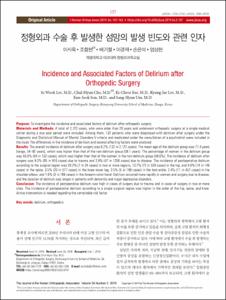KUMEL Repository
1. Journal Papers (연구논문)
1. School of Medicine (의과대학)
Dept. of Orthopedic Surgery (정형외과학)
정형외과 수술 후 발생한 섬망의 발생 빈도와 관련 인자
- Keimyung Author(s)
- Lee, Si Wook; Cho, Chul Hyun; Bae, Ki Cheor; Lee, Kyung Jae; Son, Eun Seok; Um, Sang-Hyun
- Department
- Dept. of Orthopedic Surgery (정형외과학)
- Journal Title
- 대한정형외과학회지
- Issued Date
- 2019
- Volume
- 54
- Issue
- 2
- Keyword
- 섬망; 정형외과 수술; delirium; orthopedics
- Abstract
- Purpose:
To investigate the incidence and associated factors of delirium after orthopedic surgery.
Materials and Methods:
A total of 2,122 cases, who were older than 20 years and underwent orthopedic surgery at a single medical center during a one year period were included. Among them, 132 patients who were diagnosed with delirium after surgery under the Diagnostic and Statistical Manual of Mental Disorders-V criteria and medicated under the consultation of a psychiatrist were included in the study The differences in the incidence of delirium and several affecting factors were analyzed.
Results:
The overall incidence of delirium after surgery was 6.2% (132 in 2,122 cases). The mean age of the delirium group was 77.4 years (range, 54–92 years), which was higher than that of the non-delirium group (58.1 years). The percentage of women in the delirium group was 63.6% (84 in 132 cases), which was higher than that of the women in the non-delirium group (49.0%). The incidence of delirium after surgery was 9.3% (85 in 916 cases) due to trauma and 3.9% (47 in 1206 cases) due to disease. The incidence of postoperative delirium according to the surgical region was 29.2% (7 in 24 cases) in two or more regions, 13.7% (72 in 526 cases) in the hip, and 9.6% (14 in 146 cases) in the spine, 3.5% (20 in 577 cases) in the knee-lower leg, 2.5% (5 in 199 cases) in the foot-ankle, 2.4% (11 in 457 cases) in the shoulder-elbow, and 1.6% (3 in 189 cases) in the forearm-wrist-hand. Delirium occurred more rapidly in women and surgery due to disease, and the duration of delirium was longer in patients with dementia and major depressive disorders.
Conclusion:
The incidence of postoperative delirium was high in cases of surgery due to trauma and in cases of surgery in two or more sites. The incidence of postoperative delirium according to a single surgical region was higher in the order of the hip, spine, and knee. Active intervention is needed regarding the correctable risk factor.
목적:
정형외과 수술 후 환자의 섬망 발생 빈도 및 섬망에 미치는 영향 인자를 분석하고자 하였다.
대상 및 방법:
1년간 단일 상급 종합병원에서 정형외과 수술을 시행 받은 성인 환자 2,122예를 대상으로 하였다. 이들 중 정신건강의학과 협의 진료하에 Diagnostic and Statistical Manual of Mental Disorders-V 진단 기준에 부합하며 섬망 관련 투약력이 확인된 환자 132예를 선별하였고 수술 원인 및 수술 부위에 따른 섬망 발생률의 차이와 입원 후 섬망 발생까지의 시간 및 지속 시간에 영향을 미치는 인자를 분석하였다.
결과:
전체 수술 환자 중 6.2% (132/2,122예)에서 섬망이 발생하였다. 섬망 환자군의 평균 나이는 77.4세(범위, 54-92세)로 비섬망 환자군의 평균 나이(58.1세)보다 많았고, 섬망 환자군의 여성 비율이 63.6% (84/132예)로 비섬망 환자군의 여성 비율(49.0%)보다 높았다. 외상에 의한 수술 후 9.3% (85/916예), 질환에 의한 수술 후 3.9% (47/1,206예)의 섬망 발생률을 보였다. 수술 부위별 섬망 증상의 발생률은 두 부위 이상 수술을 시행한 경우 29.2% (7/24예), 고관절 13.7% (72/526예), 척추 9.6% (14/146예), 슬관절 및 하퇴 3.5% (20/577예), 족부 및 족관절 2.5% (5/199예), 견주관절 2.4% (11/457예), 전완 및 수부 1.6% (3/189예)였다. 여성인 경우와 질환으로 수술하는 경우 입원 후 섬망이 빨리 발생하였고, 치매와 주요 우울 장애가 있는 경우 섬망 지속기간이 길게 나타났다.
결론:
외상으로 인해 수술한 경우, 두 부위 이상 수술을 받은 경우 섬망 발생 빈도가 높았고, 단일 부위에서 고관절, 척추, 슬관절 순서로 높았다. 본 연구를 통해 술 후 섬망 발생의 위험도를 예측하고 교정 가능한 인자에 대한 적극적 개입이 필요할 것으로 생각된다.
- Alternative Title
- Incidence and Associated Factors of Delirium after Orthopedic Surgery
- Publisher
- School of Medicine (의과대학)
- Citation
- Si-Wook Lee et al. (2019). 정형외과 수술 후 발생한 섬망의 발생 빈도와 관련 인자. 대한정형외과학회지, 54(2), 157–163. doi: 10.4055/jkoa.2019.54.2.157
- Type
- Article
- ISSN
- 2005-8918
- Source
- https://jkoa.org/search.php?where=aview&id=10.4055/jkoa.2019.54.2.157&code=0043JKOA&vmode=FULL
- Appears in Collections:
- 1. School of Medicine (의과대학) > Dept. of Orthopedic Surgery (정형외과학)
- 파일 목록
-
-
Download
 oak-2019-0243.pdf
기타 데이터 / 757.6 kB / Adobe PDF
oak-2019-0243.pdf
기타 데이터 / 757.6 kB / Adobe PDF
-
Items in Repository are protected by copyright, with all rights reserved, unless otherwise indicated.